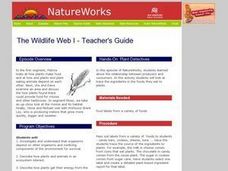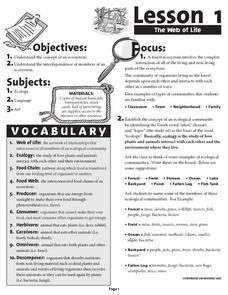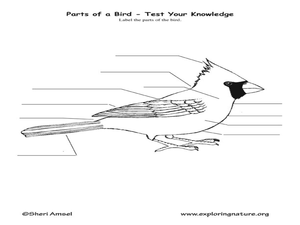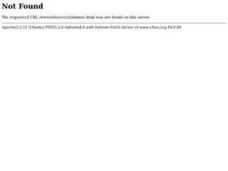Curated OER
Is Radio 1 British enough?
Students read the story Radio 1 defends not playing enough UK tunes. Students are then asked: What are the benefits of having a mix of musical cultures in a country?, Do countries lose a sense of identity when other cultures are added?...
Curated OER
Supermarket Science: The King Sooper Lab
Students read product labels, compare fat, sodium, and sugar contents of various food items. They work with a partner and often employ the assistance of the deli and bakery managers in a supermarket.
Curated OER
The Wildlife Web I
Students explore the relationship between producers and consumers. In this activity, they trace the ingredients in the foods they eat to plants. Supplement to Natureworks episode from New Hampshire Public Television, but activities may...
Curated OER
Wolf Habitat
Pupils identify their own basic needs for food, water, shelter and space in a suitable arrangement. They generalize that wolves and people have similar basic needs.
Curated OER
Eggs
Students know the following parts of an egg as the yolk, white, shell, membrane, chalaza, and air sac. They also sequence the growth of the chick in the egg. An egg is broken and students touch, smell and see it. They locate the six...
Curated OER
Get Nutty
Students research how nuts and seeds contribute to their overall good health.They recognize that nuts and seeds are a tasty addition to a meal. Students comprehend that nuts and seeds pose a risk for a small proportion of the population...
Curated OER
Texas Estuary Project
Students practice the proper lab techniques of coring, seining, taking temperatures, and salinity. Students analyze and graph data. Students write a 3 part essay and correctly draw and label a food web of their field site.
Curated OER
Yaba "Data" Cereal
Fifth graders create and modify a database using information from cereal labels.
Curated OER
The Web of Life
Students participate in a game in which they discover the balance of life in the ocean. They identify different organisms that rely on different types of food. They answer questions to complete the instructional activity.
Curated OER
Social Studies: Grab Day at the Pueblo
Students develop a cultural understanding of "Grab Day." Using magazines, they clip out pictures to make collages of items thrown down to people on this day. Students label the items in their collages.
Curated OER
Ocean Market
Students research how: The ocean is the source of many materials, from ores mined from its depths to relaxing mineral salts for a bath. Exquisite mother-of-pearl inlay, decorative shells, and pearl jewelry are found in gift shops...
Curated OER
CALORIE COUNTDOWN
Students will categorize foods according to their components and energy content.1. Design a large bulletin board with sections for carbohydrates, fats and proteins.
2. Ask students to bring labels and packages of different food products....
Curated OER
Crab Lab
Students participate in an activity in which they observe the behavior of a crab. In groups, they label and identify the function of each main part while observing and record their behavior. They make educated guesses on why they...
Curated OER
Chemical Reactions With Vinegar
Second graders observe chemical reactions. In this scientific inquiry lesson plan, 2nd graders determine whether vinegar creates a chemical reaction by observing two different experiments. A list of 7 supplies is included. In addition,...
Curated OER
Create a Habitat for an Animal
In this marine life instructional activity, students label the ocean animal and each part of its habitat. Students then draw one of the habitats including the animals and plants that live there.
Curated OER
Hand washing Laboratory Activities
Students are exposed to the benefits of many antimicrobial soaps to prevent infections. In the food-service industry, studies indicate that inadequate hand washing and cross-contamination is responsible
Curated OER
Learning Bird Traits
Students draw and label a bird. In this bird traits activity, students learn what traits make a bird different from other animals. Students are taught how to draw a bird and are expected to label the various body parts they drew.
Curated OER
Introduction to Worm Bin Project
Students observe the decomposing process of the food chain in a worm bin. They observe whether the type of food fed to worms affect the castings given off during the decomposition process. They learn and practice graphing their findings.
Curated OER
Going On A Picnic
Students classify items you would bring on a picnic into different categories. In this sorting lesson plan, students have categories of food, table things, and toys. A simple instructional activity that teaches an important skill.
Curated OER
SNACK SACK
The student will experience the concepts of ratio and production, using agricultural products considered snack foods. 2. The student will analyze and record information from the class experience.Bring in a wide assortment of packaged...
Curated OER
Wheat: Ancient and Ageless
Pupils label the parts of a wheat plant on a worksheet. In this Egyptian farming lesson, students thresh a wheat stem and estimate the amount harvested. Pupils research Ancient Egypt online.
Curated OER
Land Use Issues
Students discover seeds are a source of life. They also label the parts of a seed and examine the conditions which are needed for the seed to start growing. They follow the life cycle of seeds.
Curated OER
Trees
Fourth graders discuss the function of roots, trunk, crown, bark, cambium heartwood, and leaves of a tree. They create a tree diagram and label roots, trunk, crown, bark, cambium heartwood and leaves when shown a list of parts and an...
Curated OER
Products of the Rain Forest
Seventh graders explore products of the rain forest. They consider items from their home that may have been products of the rain forest by checking ingredients on product labels. They share their discoveries in class and create a...























